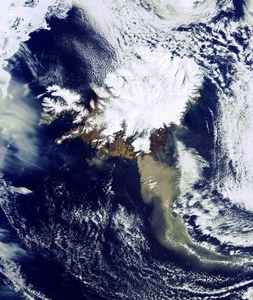
 |
![]() Le Eyjafjallajökull, volcan islandais, est entré en éruption!
Le Eyjafjallajökull, volcan islandais, est entré en éruption!
(note: les Images du jour archivées ne contiennent un texte français qu'à partir de la troisième image de la page 8 des archives)
Le volcan Eyjafjallajökull, le 5ème plus grand volcan d'Islande, est entré en éruption le 20 mars 2010. Son activité s'est soudainement accrue le 14 avril: le volcan a alors commencé d'émettre un fort nuage volcanique de cendres sur l'Atlantique nord. Ce nuage a ensuite atteint l'Europe et la Russie. Ce nuage volcanique se voit fort bien sur cette vue satellite; il s'étend à partir du volcan qui est situé à 120 km au sud-est de Reikjavik, la capitale islandaise. Le nuage de cendres a sérieusement affecté le trafic aérien européen et même mondial! La poussière de volcan contenue dans ces nuages, en effet, est extrêmement dommageable aux moteurs d'avion: des cas fréquents de moteurs d'avions de ligne qui tombent en panne sont régulièrement signalés dans les régions du monde qui connaissent plus souvent de telles explosions, telles l'Alaska ou l'Indonésie. Des nuages de cendre de cette ampleur sont beaucoup plus rares en Europe. Il semblait, qu'à partir du 21 avril, l'activité du Eyjafjallajökull avait nettement faibli. Le volcan, cependant pourrait rester actif pendant des semaines voire des mois -avec d'autres émissions, par intervalle, de nuages de cendres- car, en 1821, par exemple, le Eyjafjallajökull était entré en éruption pendant plus d'une année... Plus alarmant encore est le fait que le Katla, un volcan voisin du Eyjafjallajökull, 13 km à l'Ouest, pourrait être affecté voire réveillé. Alors même que les chambres magmatiques des deux volcans ne sont pas les mêmes, il se trouve que chaque fois que le Eyjafjallajökull est entré en éruption, le Katla est devenu actif aussi, ce qui s'est vérifié pour chacune des trois éruptions du Eyjafjallajökull qui ont été suivies. Le Katla, de plus, est beaucoup plus dangereux. Enfin, il n'est pas entré en éruption depuis 1918 alors que l'on sait qu'il se réveille tous les 40 à 80 ans (ce qui fait, d'ailleurs, que ce délai moyen est actuellement dépassé). Le Katla et le Eyjafjallajökull continuent donc d'être étroitement surveillés par les vulcanologues islandais. ESA